Theory and Simulation
Theory and Simulation

Theory and simulation studies play an important role in understanding various phenomena occurring in compound, complex systems such as fusion plasmas. In particular, large-scale simulation utilizing world-class supercomputers has progressed in plasma and fusion science ahead of other academic fields. The purpose of this program is to promote research and education toward the theoretical systemization of plasma physics, in addition to lectures on various methodologies and scientific visualization needed for simulation studies. Further, we are exploring simulation science as a new frontier of science through the construction of an integrated predictive modeling for a fusion system.
Fusion Theory and Simulation Research
Magnetically confined fusion plasma shows very complicated behavior due to the interlocking of various physical factors. Therefore, it is essential to understand its behavior well for the prediction of experimental results and the proposal of a new experimental plan. In simulation studies, physical mechanisms governing complicated behaviors of magnetically confined fusion plasma are investigated through the following research topics.
Magnetohydrodynamic Simulation of LHD Plasmas
We analyze the changes in the global plasma structure through simulations based on MHD simulations for the collapse and the relaxation phenomena observed in the LHD experiments. Then, we aim to give new suggestions on the interpretation of the experimental results and the previous concepts for the global stability. Practical themes of study and education include the effects of shear flows on the stability of the interchanged modes, MHD simulation including diamagnetic effects, interaction between resonant magnetic perturbations and pressure driven modes, and others. We also work toward development of new numerical codes and visualization of the calculation results.
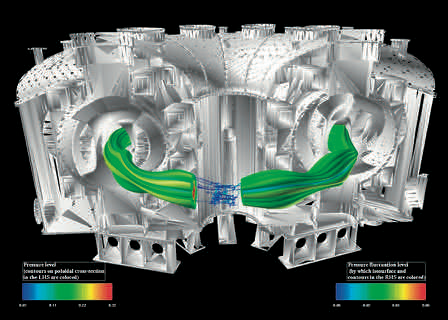

Interaction between energetic particles of LHD Plasmas and magnetohydrodynamic (MHD) modes
The interaction between the energetic particles and the MHD modes in fusion plasmas and the particle fluid hybrid simulations of this problem are studied. The interaction between the energetic particles and the MHD modes is a research issue of primary importance for burning plasmas where energetic alpha particles are created. The interaction involves interesting topics of plasma physics, such as MHD waves and Landau damping/growth.
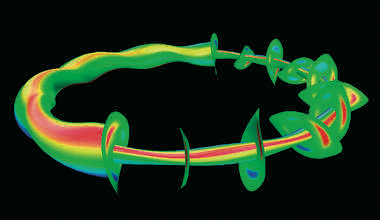
Turbulent transport phenomena in fusion plasmas
Understanding of turbulent transport of particles and heat is one of the central issues in fusion plasma research. In order to predict turbulent transport, we develop gyrokinetic simulations calculating turbulence in the five-dimensional phase space and aim to understand the physics of turbulence, which is a complex nonlinear dynamics of plasmas and exhibits self-organization, such as zonal flow production. By utilizing data of the gyrokinetic simulations in the five-dimensional space, we will construct a one-dimensional model that can be a part of a set of simulation codes for predicting the fusion plasma confinement.
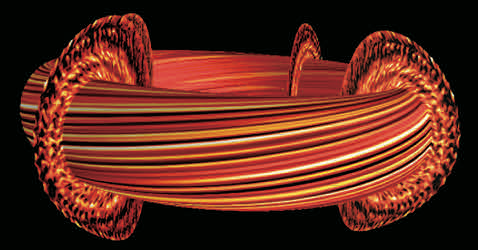
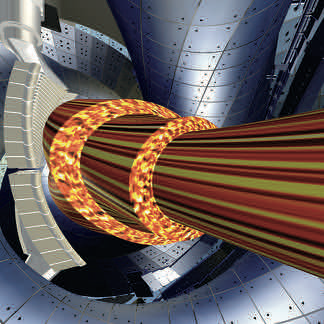
Research on the neoclassical transport phenomenon in fusion plasma
Complicated trajectories of charged particles confined in a three-dimensional magnetic torus, which are scattered by Coulomb collisions among the particles, produce the particle and heat flux called “neoclassical transport.” The aim of theory and simulation research on the neoclassical transport phenomenon is to evaluate the neoclassical transport, which strongly depends on the magnetic topology (tokamak, helical, etc.), plasma temperature, and density, as well as the ambipolar radial electric field which evolves spontaneously in torus plasmas. The neoclassical transport simulation is utilized to study the plasma confinement properties, the effect of the ambipolar electric field on the turbulent transport, the effect of the neoclassical viscosity on plasma rotation, and other topics.
Edge plasma transport in helical system plasmas
Edge plasma transports in the magnetically confined fusion plasma are studied by numerical simulations. In particular, the transport in the stochastic field of the three-dimensional magnetic configuration is considered. In our group, numerical simulation codes of heat, particles, neutrals, and impurities are being developed based on the fluid and drift kinetic models. The development of numerical schema for the edge plasma transport is also an important task.
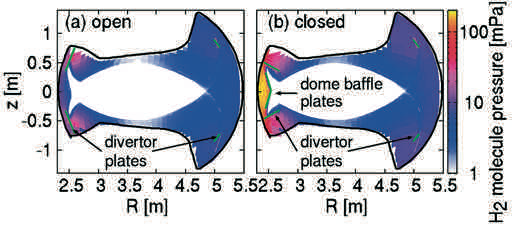
The simulation covers the stochastic region and also divertor legs.
Other main research topics
- Transport simulation in tokamak plasma
- Ablation simulation of solid hydrogen by multi-phase extension model of magnetohydrodynamics
- Extension of the magnetohydrodynamics equilibrium
- High-beta plasma simulation
- Theoretical analysis of magnetic field structure in the periphery region of LHD
Theoretical Analyses of Magnetically Confined Plasmas
It is a formidable challenge to reproduce all complicated behaviors of plasmas by direct numerical simulation at the present time, and in the future even if computer performance is greatly improved. Therefore, construction of theoretical models is indispensable to bridge the gap between simulation and reality. Here, research topics of theoretical analyses are presented.
Theoretical analyses of transport phenomena in fusion plasmas
Transport of particles and heat is studied analytically based on fluid equations in threedimensional space and on kinetic equations in five-dimensional space. Micro-instabilities driving turbulence and the production of mean flow reducing the instability are investigated by means of modern formulations with Lagrangian and Hamiltonian analyses, which are advantageous in utilizing symmetry and conservation properties of the equations. The reliable reduction from kinetic equations to fluid equations is also studied.
Theoretical Analysis Based on Magnetohydrodynamics
We are making progress in the field of MHD and confinement theories by utilizing fluid models of plasmas. In particular, we develop theories and numerical calculation schemes for extension of the analyses from static equilibria with isotropic pressure to equilibria with global flows and anisotropic pressure, spectrum analysis of linear MHD modes in both stable and unstable sides, inclusion of the flows and the spontaneous currents predicted by the neoclassical transport theory, and extension of the model equations by including the twofluid effects and kinetic effects in three dimensional magnetic configurations. We also discuss the validity of the theories by comparing the results with the experimental observations.
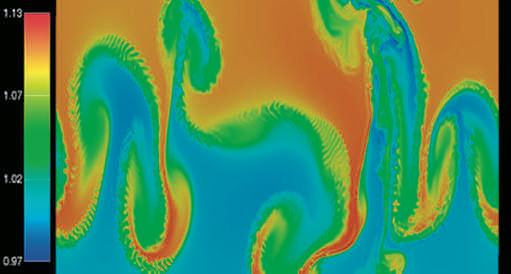
Transport analysis of improved confinement mode
The purpose of transport analysis is to clarify the physical mechanism of the electric field structure and the flow, which strongly affect the plasma confinement. To realize the nuclear fusion plasma, the transport of the improved confinement mode is studied. Due to the nonlinearity of the electric field determined by the neoclassical transport, the transition (bifurcation) phenomena are found in the electric field structure. The effect of the transition phenomena on the turbulence transport is studied by formulation and analysis, and we aim to achieve the improved confinement mode.
Complexity Plasma Simulation
Plasmas and other physical systems show common physical phenomena such as selforganization and intermittent energy release. We aim at the formulation of a novel theoretical framework by treating physical issues caused by complexity. Obtained knowledge can be applied to not only fusion plasmas but also to astrophysics and material science.
Dynamics of collisionless magnetic reconnection in the three-dimensional open system
We advance our research on the dynamics and self-organization phenomena of the structure formation in the plasma by large-scale simulation. For example, we study 1) the multi-hierarchy simulation model in which macroscopic and microscopic physics are expressed consistently and simultaneously on the collisionless magnetic reconnection, 2) the particle simulation on plasma instability and anomalous resistivity in the current sheet, 3) the dynamics of plasma structure formation in the energy open system, and 4) the physics of the structure formation and self-organization in the magnetic-confinement plasma, and other topics. We will provide education and advance the research in these fields.
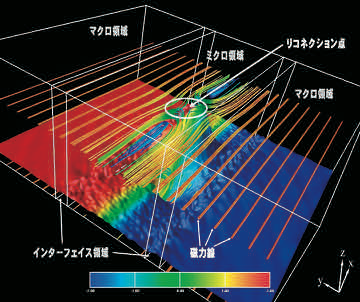
Research on basic plasma phenomena by means of particle simulations
We study basic physical processes of edge plasma by means of particle simulations. In particular, dynamics of plasma near solid wall and structural formation related to the interaction between plasma and neutral gas are investigated by using a supercomputer.
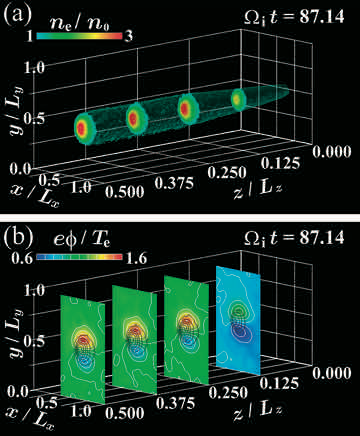
Research on plasma-material interaction on atomic-level simulation
The phenomena due to the plasma-material interaction (PMI) which is caused by the boundary region between plasma and the inner wall in the fusion reactor are investigated at atomic-scale by using numerical computer simulation. To simulate the PMI phenomena, it is necessary to develop the multiscale modeling composed of moleculardynamics (MD), density functional theory (DFT), binary collision approximation (BCA), and Monte-Carlo (MC) methods. Recent progress is the development of the hybrid simulation among these methods. The hybrid simulation enables us to treat the multi-physical processes in the PMI, such as the formation processes of a helium nano-bubble and a fuzzy nano-structure on the tungsten surface bombarded by helium plasma.
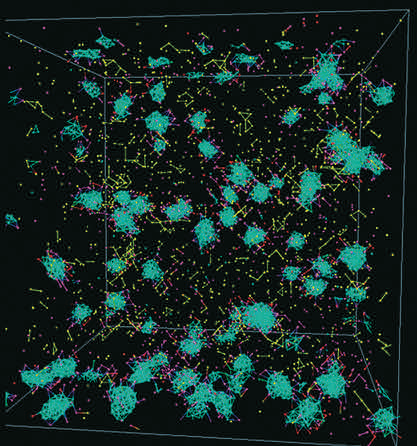
Other principal research topics
- Molecular dynamics simulation on the collision process between hydrogen and carbon material
- Particle acceleration by shock wave
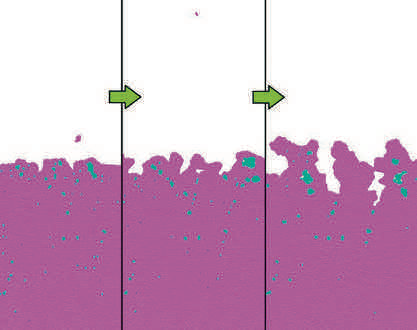
Development of Simulation Methods
In order to advance the simulation research it is necessary to address issues concerning the methods, for example, how to model numerically the real physical world, how to calculate such huge numerical data efficiently, and how to express the simulation results for understanding. This program also attaches great importance to the development of challenging simulation approaches that go beyond the framework of conventional methods.
Virtual-reality system
The numerical simulation results on various complex phenomena generally show very complex shape structures and behaviors spatiotemporally. We are investigating the immersive virtual-reality (VR) system which can display the complex structures in the three-dimensional space as they are. When the viewer wearing the exclusive glasses with the sensor comes into the room surrounded by four screens, the system makes the viewer feel as it s/he is in the simulation world feeling deep immersion, and this helps the intelligent thinking process. Using this system, we are attempting an implementation toward the optimization of the experimental device by re-creating an authentic-looking device in the VR world in addition to conducting research on understanding the complex structure in the numerical solutions.
Other principal research topics
- Construction of an advanced simulation system
- Development of a numerical calculation scheme with high accuracy and high efficiency
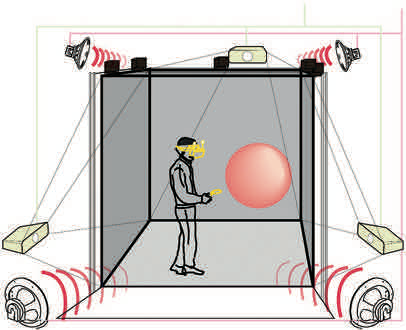
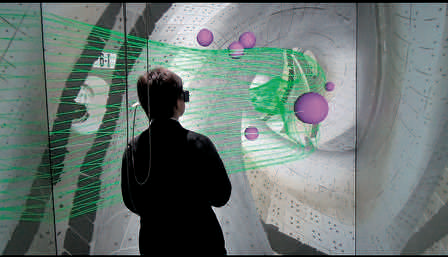
Plasma Simulator RAIJIN
In order to support the clarification and the systematization of the physical mechanisms of fusion plasma confinement, the search of complexity science as basic research which support them, and the collaborative research which establishes the simulation science, NIFS developed this system. Called “Plasma Simulator RAIJIN,” this is a composite system from the execution of the simulation to the data processing, including the above-mentioned VR system through the high-speed network in order to advance consistently and efficiently the collaborative research on simulation. The main massive parallel computer server is SX-Aurora TSUBASA (4,320 Vector Engines (VE)) by NEC, which was introduced in July 2020. The capacity of the main memory is 202 tebibytes and the computational performance is 10.5 petaflops.
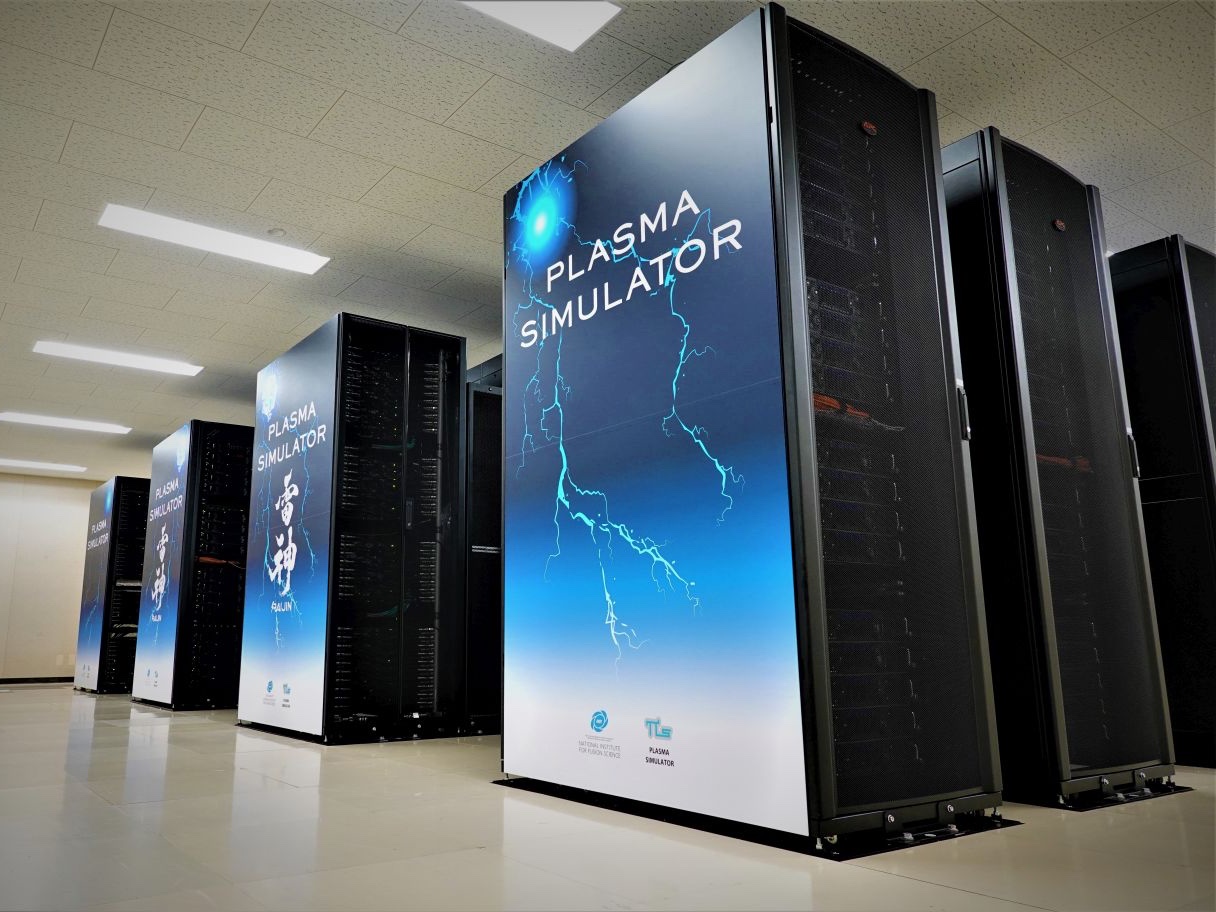
SX-Aurora TSUBASA
4,320 VEs
202 TiB (total VE main memory)
10.5 PFlops(total VE computational performance)

The effective capacity: 32.1 petabytes





